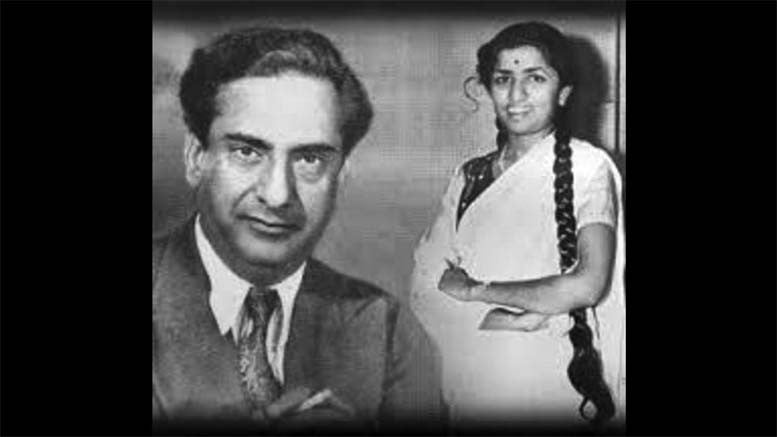
A pioneer of film music and composition

It may seem strange today, but after the India-Pakistan partition, many successful and famous people did not receive the type of accolade Bollywood and Lollywood stars do today. For Pakistani Muslims this was even stranger as the country was created to safeguard, protect and promote Muslim talent against unfair competition in British India.
Shaukat Hussain Rizvi and Imtiaz Ali Taj were shadows of their former self after 1947, their new achievements nothing compared to their previous glory. Ghulam Haider, was also a part of this club.
Master Ghulam Haider is considered a pioneer of film music. Though the likes of Master Jhande Khan and various Bengali composers had initiated it, Haider was the one who solidified the evolution and established the rules of structure which have now become the standardized norms of film music. Indeed, South Asian movies are notoriously well-known for their song and dance numbers, integral to local cinema.
Master Ghulam is also credited with introducing two legends of film music -- Noor Jehan and Lata Mangeshkar. Jehan was only, Baby Noor Jehan when he spotted her in Sheela pind di kurri. She sang lang aa jaa pattan Chana da yaar with her sisters. Her rendition was so beautiful, Haider featured her in Gul Bakauli (1939) as a soloist. He catapulted her as the leading female film vocalist in the late 1930s after her song Shala Jawanian Mane. It was after their composition of Khandaan (1965) that they become the most sought after vocalist and composer duo. It would not be wrong to say that Noor Jehan crafted the film song along with LK Saigal; working with gifted composers they established a new genre in popular music.
Haider also saw a star in Lata Mangeshkar who was initially a chorus singer and small-role actress. Her father, Dina Nath Mangeshkar had accumulated huge debts against his theatre company. After his death she was forced to work and keep the hearth warm at home. She did work she was offered without fuss, knowing she had no choice. Ghulam Haider, on the other hand, knew she was meant for great things, and wanted her to sing solo. The directors and producers in the industry at the time, were not willing to prefer a teenage girl with a thin delicate voice over the volume powerhouses available to them. Haider was angered and deeply upset over their reaction, but persisted in finding her a solo break. He finally got her, her break in the film Jeven Yatto (1946). This was acknowledged by leading composers like Khem Chand Prakash, Husan Lal Bhagat Ram, Naushad, Shanker Jaikishen and Anil Biswas, who also said they preferred her over any female vocalist for decades to come.
Born in Sindh and raised in the Punjab, Master Ghulam began his career as most film composers did -- in theatre. He was a harmonium player, who switched to composing music for films as talkies became popular in a matter of months, and the sub-continental film industry was expanding at a rapid pace.
In British and European-owned orchestras and theatres, musicians or composers who conducted musicial arrangements were given the title of ‘master’ from the European maestro. In our lexicon such a musical expert is called ustad or pundit, depending on religious denomination.
Master Ghulam Haider was particularly popular due to the lively, rhythmic composition of his music. There was also a touch of western music --not its classical repertoire, rather contemporary folk and jazz music; which some Indian composers, vocalists and instrumentalists were becoming increasingly attracted to. In other words, he was not a purist like Bengali composers RC Boral, Taimeer Baran and Pankhaj Mallick. They were greatly influenced by Bengali folk music and the innovations that Rabindronath Tagore had made in his Rabindro sangeet or the Tagore geeti. It is not possible to criticize Tagore for he is treated as a god, which Khushwant Singh found to his peril, even sixty years after Tagore’s passing. But he was mortal, and all mortals may be judged and assessed. Master Ghulam, greatly influenced by Punjabi and Sindhi folk music, incorporated them in his compositions, weaning music away from the Bengali comprehension and composition, as conceived by Tagore.
Belonging to the Rabbi clan of musicians, he was like other rabbis, brilliant at creating lighter forms of music; when kheyal and thumri are considered by aficionados. The family was originally from Taran Taaran; with the liturgical music of the Sikhs in his blood, he channeled its effects in compositions for recording, theatre and later film companies.
Moving to Pakistan after 1947, his glory was diminished by lack of opportunities. There were sparse resources and only a few vocalists to work with. This dampened his talent and ambitions. Among others he made Shahida and Gulnar in Pakistan, with his old teammate Shaukat Hussain Rizvi, but their success was limited. He died on November 9, 1953, before he was even fifty. However remains immortalized in the legends he launched such as Noor Jehan and Lata Mangeshkar. His influence and shaping of film composition in South Asia are still evident today.